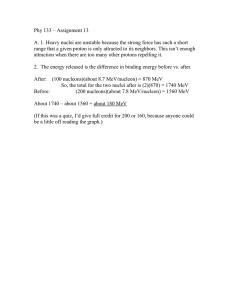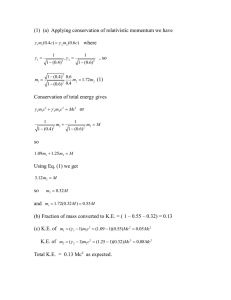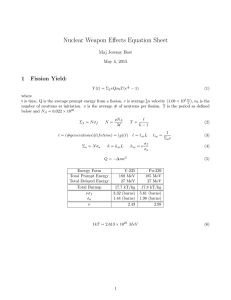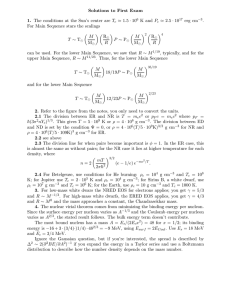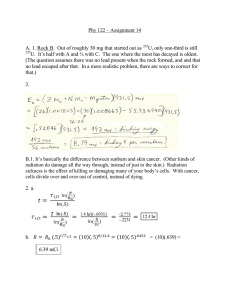Document 12454267
advertisement
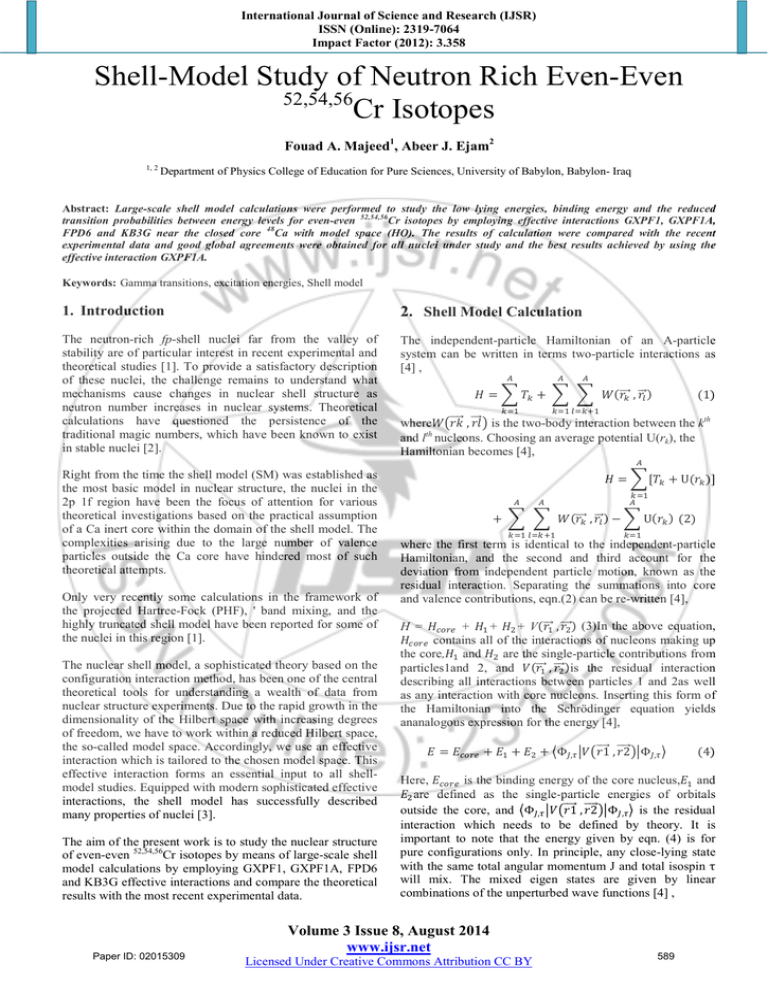
International Journal of Science and Research (IJSR) ISSN (Online): 2319-7064 Impact Factor (2012): 3.358 Shell-Model Study of Neutron Rich Even-Even 52,54,56 Cr Isotopes Fouad A. Majeed1, Abeer J. Ejam2 1, 2 Department of Physics College of Education for Pure Sciences, University of Babylon, Babylon- Iraq Abstract: Large-scale shell model calculations were performed to study the low lying energies, binding energy and the reduced transition probabilities between energy levels for even-even 52,54,56Cr isotopes by employing effective interactions GXPF1, GXPF1A, FPD6 and KB3G near the closed core 48Ca with model space (HO). The results of calculation were compared with the recent experimental data and good global agreements were obtained for all nuclei under study and the best results achieved by using the effective interaction GXPF1A. Keywords: Gamma transitions, excitation energies, Shell model 1. Introduction 2. Shell Model Calculation The neutron-rich fp-shell nuclei far from the valley of stability are of particular interest in recent experimental and theoretical studies [1]. To provide a satisfactory description of these nuclei, the challenge remains to understand what mechanisms cause changes in nuclear shell structure as neutron number increases in nuclear systems. Theoretical calculations have questioned the persistence of the traditional magic numbers, which have been known to exist in stable nuclei [2]. The independent-particle Hamiltonian of an A-particle system can be written in terms two-particle interactions as [4] , Right from the time the shell model (SM) was established as the most basic model in nuclear structure, the nuclei in the 2p 1f region have been the focus of attention for various theoretical investigations based on the practical assumption of a Ca inert core within the domain of the shell model. The complexities arising due to the large number of valence particles outside the Ca core have hindered most of such theoretical attempts. Only very recently some calculations in the framework of the projected Hartree-Fock (PHF), ' band mixing, and the highly truncated shell model have been reported for some of the nuclei in this region [1]. The nuclear shell model, a sophisticated theory based on the configuration interaction method, has been one of the central theoretical tools for understanding a wealth of data from nuclear structure experiments. Due to the rapid growth in the dimensionality of the Hilbert space with increasing degrees of freedom, we have to work within a reduced Hilbert space, the so-called model space. Accordingly, we use an effective interaction which is tailored to the chosen model space. This effective interaction forms an essential input to all shellmodel studies. Equipped with modern sophisticated effective interactions, the shell model has successfully described many properties of nuclei [3]. The aim of the present work is to study the nuclear structure of even-even 52,54,56Cr isotopes by means of large-scale shell model calculations by employing GXPF1, GXPF1A, FPD6 and KB3G effective interactions and compare the theoretical results with the most recent experimental data. Paper ID: 02015309 � � � � = � �� + � � �(������ , ����) � ��� (1) ��� ����� ����� , ���� where���� �� � is the two-body interaction between the kth th and l nucleons. Choosing an average potential U(rk), the Hamiltonian becomes [4], � � � � = �[�� + U(�� )] ��� � + � � �(������ , ����) � − � U(�� ) (2) ��� ����� ��� where the first term is identical to the independent-particle Hamiltonian, and the second and third account for the deviation from independent particle motion, known as the residual interaction. Separating the summations into core and valence contributions, eqn.(2) can be re-written [4], H = ����� + �� + �� + V(������ , �����) � (3)In the above equation, ����� contains all of the interactions of nucleons making up the core,�� and �� are the single-particle contributions from the residual interaction particles1and 2, and �(������ , �����)is � describing all interactions between particles 1 and 2as well as any interaction with core nucleons. Inserting this form of the Hamiltonian into the Schrödinger equation yields ananalogous expression for the energy [4], ����� , ����� �2��Φ�,� � � = ����� + �� + �� + �Φ�,� ����1 (4) Here, ����� is the binding energy of the core nucleus,�� and �� are defined as the single-particle energies of orbitals ����� , ����� outside the core, and �Φ�,� ����1 �2��Φ�,� � is the residual interaction which needs to be defined by theory. It is important to note that the energy given by eqn. (4) is for pure configurations only. In principle, any close-lying state with the same total angular momentum J and total isospin τ will mix. The mixed eigen states are given by linear combinations of the unperturbed wave functions [4] , Volume 3 Issue 8, August 2014 www.ijsr.net Licensed Under Creative Commons Attribution CC BY 589 International Journal of Science and Research (IJSR) ISSN (Online): 2319-7064 Impact Factor (2012): 3.358 � (��,� )� = � ��� ( Φ�,� )� ��� (5) where g is the number of configurations that mix and the label p =1,2,..., g. The coefficients akp fulfill the condition [4], � � | ��� |� = 1 ��� Inserting eqn. (5) into the schrödinger equation gives, �(��,� )� = �� (��,� )� which leads to a system of linear equations [4]. (6) (7) 3. Results and Discussions 3.1 Excitation Energies The core are taken at 48Ca for all nuclei under study with 4,6 and 8 valence nucleons for 52Cr, 54Cr and 56Cr respectively. Figure 1 present the compassion between our theoretical work and the experimental for 52Cr isotope. Our theoretical work predicts the 2+ state at 1.483 MeV, 1.286 MeV, 1.381 MeV and 0.830 MeV by employing the effective interactions GXPF1, GXPF1A, FPD6 and KB3G respectively. By comparing them with experimental value 1.434 MeV we obtained the best agreement at GXPF1interaction. For 4+ the theoretical results are 2.277 MeV, 2.081 MeV, 2.125 MeV and 1.430 MeV by employing the same effective interactions respectively. We can notice from the figure that the experiment value at 4+ 2.369MeV has a good agreement with GXPF1 interaction like 2+ state. Figure 1: Comparison of the experimental excitation energies taken from Ref [5] with the present theoretical work using GXPF1, GXPF1A, FPD6 and KB3G effective interactions. Figure 2 presents the calculated excitation energy levels for 54 Cr with 6 particles outside core. Our calculations predicts the values1.075 MeV, 0.939 MeV, 0.973 MeV and 0.667 MeV for2+state by employing GXPF1, GXPF1A, FPD6 and KB3G effective interactions respectively which compared with experimental value at 0.834 MeV. The 4+ state is predicted with values 2.128 MeV, 1.885 MeV, 1.941 MeV Paper ID: 02015309 and 1.431 MeV by employing the same effective interactions respectively and compared with experimental value 1.823MeV. The best agreement with experimental value is achieved at GXPF1A interaction for both 2+ and4+ states. Volume 3 Issue 8, August 2014 www.ijsr.net Licensed Under Creative Commons Attribution CC BY 590 International Journal of Science and Research (IJSR) ISSN (Online): 2319-7064 Impact Factor (2012): 3.358 Figure 2: Comparison of the experimental excitation energies taken from Ref [5] with the present theoretical work using GXPF1, GXPF1A, FPD6 and KB3G effective interactions. The effective interactions GXPF1, GXPF1A, FPD6 and KB3G were employed for 56Cr with 8 particles outside core 48 Ca and model space (HO) as shown in Figure 3. The results of the excitation energies for 2+are 1.283 MeV, 1.134 MeV, 1.139 MeV and 0.842 MeV respectively and compared with the experimental value 1.006 MeV. The excellent agreement was achieved at GXPF1A interaction. The 4+ we obtained the values 2.262 MeV, 2.011 MeV, 2.014 MeV and 1.542 MeV by employing the same effective interactions respectively and compared with experimental data 2.681 MeV which has best agreement with GXPF1 interaction. Figure 3: Comparison of the experimental excitation energies taken from Ref. [5] with the present theoretical work using GXPF1, GXPF1A, FPD6 and KB3G effective interactions. 3.2 Reduced Transition Probabilities � → The electromagnetic transition probabilityB(E2;0�.� � 2� )values calculated for both model spaces and interactions are compared with experimental data for Cr isotopes. The effective charges for proton and neutron are evaluated by taking the average value of the effective charge for proton and neutron from the fitting with the experimental values for all Cr isotopes studied in the present work. Therefore for ��� GXPF1A interaction the effective charges are �� = 0.68e Paper ID: 02015309 ��� for proton and�� = 0.49e for neutron. For FPD6 effective ��� ��� interaction the values are �� = 0.68e for proton and�� = 0.49e for neutron. From Fig.4 we can see although these effective interacting are successful in describing the energy levels for the Cr isotopes are less successful in describing the reduced transition probabilities and instead the core polarization effect should be included from the closed core which might improve the calculations. Volume 3 Issue 8, August 2014 www.ijsr.net Licensed Under Creative Commons Attribution CC BY 591 International Journal of Science and Research (IJSR) ISSN (Online): 2319-7064 Impact Factor (2012): 3.358 4. Conclusions In the present work large scale shell model calculations have been performed for neutron rich even-even Cr isotopes with A=52,54,56 in full fp space without truncation by employing GXPF1, GXPF1A, FPD6 and KB3G effective interactions. The facts that core-polarization polarization contribution is considered through the effective charges are not always an adequate choice for the calculation for the reduced transition probabilities and the core polarization should be included through a microscopic theory. The systematic study of the low-lying 2�� and 4�� when compared with experiment our results exhibit an agreement that may be considered quite well. The experimental binding energy are very well reproduced by the current shell model calculation. 5. Acknowledgements Figure 4: Comparison of the large-scale scale shell model calculations using FPD6 (stars) and GXPF1 (diamonds) � effective interactions with the experimental B (E2;0�.� → 2�� ) strengths (closed circles) for the chain in of even-even Cr isotopes. Experimental data are taken from Ref.[6]. 3.3 Binding Energies For the chain of Cr isotopes we obtained binding energies by employing the best interactions FPD6 and GXPF1A as shown in Fig.5 .We can see that both interactions have excellent agreement with the experimental data for all isotopes of Cr. The authors would like to acknowledge the financial support from the department of physics, college of education for pure sciences, University of Babylon. References [1] Y. K. Gambhir, S. Haq, and J. K. Suri “Number conserving shell model for evenCa, Ti, Cr, and Fe isotopes” ,Physical Review C 25, pp. 630-649, 1982. [2] K. Kaneko, Y. Sun,M. Hasegawaand T. Mizusaki“Shell model study of single- particle and collectivestructure in neutron-rich neutron Cr isotopes” , Physical ReviewC78,064312 064312,2008. [3] NaofumiTsunoda, Kazuo Takayanagi, Morten HjorthJensen, Takaharu Otsuka “Multi-shell effective interactions ” , Physical Review C 89,024313, 2014. [4] P. J.Brussaard and P. W. M. Glaudemans, “ Shellmodel applications in nuclear spectroscopy”, (NorthHoland, Amsterdam, 1977). [5] J.Tuli, Evaluated nuclear structure data file (ensdf), (accessed January 17, 2014). http://www.nndc.bnl.gov/ensdf/ [6] J. Tuli, National nuclear data center (nndc), (accessed February 23, 2014). http://www.nndc.bnl.gov/be2/ [7] J. Tuli, National nuclear data center (nndc), (accessed April 06, 2014). http://www.nndc.bnl.gov/masses/mass.mas03/ Author Profile Figure 5: Comparison between calculated binding energy (in units of MeV) with their corresponding experimental data for even-even Cr isotopes. Experimental data taken from Ref.[7]. Paper ID: 02015309 Fouad A. Majeed born in Babylon (1974).He is assistant professor at University of Babylon. His fields of expertise are study of nuclear reactions and nuclear structure. He has received awards as visiting scientist from The Abdus Salam (ICTP) ( and post-doctoral fellow from TWAS-CNPq. He obtained his B.Sc. from AlMustansiriyah University 1997, his M.Sc. (2000) and Ph.D. (2005) from Al-Nahrain University. Volume 3 Issue 8, August 2014 www.ijsr.net Licensed Under Creative Commons Attribution CC BY 592


